
Welcome to 'just old flies,' a section of methods and flies that used-to-be. These flies were tied with the only materials available. Long before the advent of 'modern' tying materials, they were created and improved upon at a far slower pace than today's modern counterparts; limited by materials available and the tiers imagination.
Once long gone, there existed a 'fraternity' of anglers who felt an obligation to use only the 'standard' patterns of the day. We hope to bring a bit of nostalgia to these pages and to you. And sometimes what you find here will not always be about fishing. Perhaps you will enjoy them. Perhaps you will fish the flies. Perhaps?
ART WINNIE'S VICTORY FLY


Art Winnie and his brother Bert ran a barber shop on Front Street in Traverse City, Michigan back in the early 1900's. They were both avid sportsmen so it's only logical that the barber shop bustled with hunters and fishermen. Both Art and Bert not only cut hair in the shop but also used it as an outlet to ply their trade as fly tiers and lure makers.
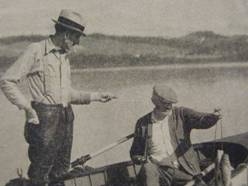
(Bert on the left , Art on the right)
highly instrumental in the development of fishing
in western Michigan.
Art Winnie, in the early 1920's, developed a famous fly called 'Winnie's Michigan Caddis,' aka, 'Michigan Caddis' or 'Winnie's Fore-And-Aft.' Later, in the early 1940's, he developed another famous fly the, 'Michigan Hopper.' Over the next decade the fly would undergo many changes and was so popularized by a man named Joe Brooks that the fly eventually took his name and is now called 'Joe's Hopper.' This pattern is one of the most popular grasshopper patterns in the country.
Another famous pattern created by Art Winnie was known as the 'Victory Fly.' This was a fly never intended to be taken seriously as a fishing pattern but rather one designed as a symbol of American patriotism. Art designed the fly between 1941 and 1945. In the opinion of this author, it was probably designed shortly after we declared war on the Japanese which would place it's creation in late 1941 or early in 1942.
The 'Victory Fly' incorporated red white and blue colors and was, not only, tied on standard hooks but on pins as well, allowing people to wear it as a broach or lapel pin.
President Franklin D. Roosevelt is said to have worn one of Art's 'Victory Flies' on his lapel on more then one occasion.
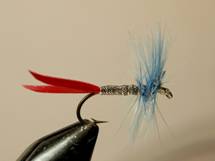
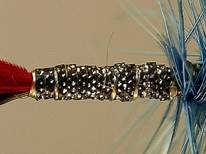 The fly is of simple construction; red duck quills for the tail, a blue hackle and a strange body material that I can't put my finger on. I'm sure it is not what we would call a standard body material. When light would strike the fly pattern it would reflect a silvery-white appearance. I have photographed an
The fly is of simple construction; red duck quills for the tail, a blue hackle and a strange body material that I can't put my finger on. I'm sure it is not what we would call a standard body material. When light would strike the fly pattern it would reflect a silvery-white appearance. I have photographed an
(photograph of actual Art Winnie fly)
enlargement of the body section so that you can examine it more closely. The best I can come up with is that it was a ribbon like material that was probably available at a dry goods or millinery store.
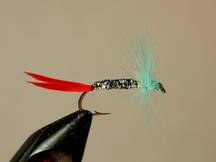
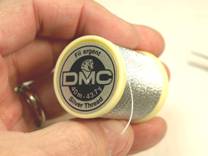 In the spirit of saving an old fly pattern I have attempted to recreate the fly using a body of black floss and silver thread,
In the spirit of saving an old fly pattern I have attempted to recreate the fly using a body of black floss and silver thread,
twisted together then wrapped forward.
The original fly was in poor condition. Whether it was tied poorly from the beginning or damaged over the years because of handling or poor storage, it's hard to say. The thread color of the head is not discernable. The only head appearing is a large irregular glop of head cement. My imitation was tied with black thread, which is what the 'old tiers' used but in keeping with the spirit of the fly he may have used a red, white or blue thread.
This pattern was long thought to have disappeared to the annals of history until one was recently discovered in a private collection of Art Winnie's flies.
See you on the water…..
Tom Deschaine
 Tom is an established fly tyer from Westland, Michigan. He writes many articles for web sites and also maintains his own, modest web site which specializes in 'old dry flies' from the Michigan area. He invites you to visit and contribute to his site. ~www.michigandryflies.net~
Tom is an established fly tyer from Westland, Michigan. He writes many articles for web sites and also maintains his own, modest web site which specializes in 'old dry flies' from the Michigan area. He invites you to visit and contribute to his site. ~www.michigandryflies.net~
[ HOME ]
[ Search ] [ Contact FAOL ] [ Media Kit ]